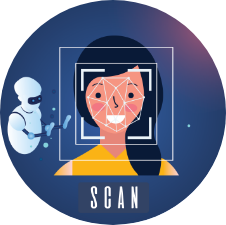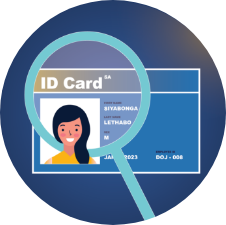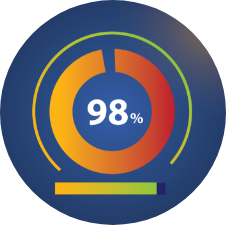Concerns
When Moving Exams Online
As education and assessments increasingly shift online, the full benefits can only be realised if the procedures of exams are also conducted digitally. However, this transition presents two significant challenges: impersonation and the excessive use of cheating aids, both of which threaten the integrity of exam outcomes.
Groundbreaking technology
guarantees Unparalleled Test Integrity

Impersonation and Cheating
In online exams, the remote setting presents significant challenges to maintaining integrity. Verifying the true identity of the test-taker is difficult, raising the risk of impersonation, where a proxy may take the exam in place of the legitimate student. Additionally, test-takers may resort to dishonest practices such as seeking external help, browsing the Internet, or using unauthorised materials like books and cheat sheets, all of which undermine the fairness and credibility of the examination process.
How Does
Online ID Verification Work?
Identity verification is a crucial process conducted before test-takers are permitted to take an exam, designed to prevent proxies or impersonators from taking the test on behalf of the legitimate candidate.
Online identity verification utilises AI-assisted facial mapping. The test taker's identity is confirmed through a headshot, ID card, driving licence or other official identification.
The verification process involves capturing headshots of test-takers and images of their ID cards using the computer’s camera, ensuring accurate and secure identification before the assessment begins.

Headshot image sent to AI for Face recognition engine


Face Mapped with Registered Photo


Card image clicked and verified


High level of confidence allows student to enter the test
The test-taker’s headshot and ID card images are processed by an AI-powered facial recognition engine, which compares them to the registered photo. The system then provides a confidence score or match percentage to the proctor. For example, if a test-taker’s face matches their registered photo with a confidence level of 95%, the AI automatically authenticates their identity. However, if the match is below a certain threshold, the system can block test access to prevent potential impersonation.
Manual verification involves a human proctor comparing the test-taker's ID photo to their live image. This method is used when there are discrepancies in automated verification or when AI verification is unavailable.
Continuous verification uses AI to monitor the test-taker throughout the exam. It ensures the person remains the same throughout the session by continuously verifying the face and comparing it to the registered image.
Online
Identity Verification Modes
High Test-Taker Volume
The AI-Assisted ID Verification mode is typically utilised when the number of test-takers is substantial, and the availability of proctors for manual verification is limited.
High Stakes Examinations
The AI-Assisted Manual Verification mode is generally employed in high-stakes exams where the test-taker count is lower, allowing for sufficient proctors to manually verify each identity.

In high-stakes examinations, institutions often mandate human proctors to validate the identity of each test-taker. However, when the volume of test-takers is significant, this process can become time-intensive. To mitigate delays, DigiProctor’s unique 'ID Verification Queue' feature enables test-takers to auto-authenticate and proceed with the exam.
Test-takers are then placed in the ID Verification Queue, where proctors can manually verify identities during the examination. Should the online ID verification fail, the test-taker will be disqualified and required to exit the test, preventing them from continuing with the exam.
FAQs:
Making Test Taker’s ID Verification Fail Safe
Test Taker’s Official ID Photo Fraud
There is risk of students creating photoshopped versions of their identity cards with their headshot image on it replaced with that of an impersonator’s, to fool proctors during the identity verification.
To allay this risk, copies of the official photos of candidates held in records of the institution are uploaded into DigiProctor prior to the exam. While digitally verifying a candidate’s headshot/identity card image, the candidate’s official photo is also displayed on the proctors screen, which makes it easy for proctors to detect frauds.
Continuous Identity Verification
Continuous Identity verification must be done to mitigate the risk of students getting their identity verified before the test and then getting someone else to appear for the test after the verification.
Most digital ID verification tools validate the user's identity only at the entry-level. To avoid such frauds, DigiProctor does continuous online identity verification during the test. For this, headshot images of students taking the exam are clicked in the background at periodic intervals and passed through the AI engine for face match to ensure that the person taking the test is legitimate and not an impersonator.
TThe students are permitted to start their test only after identity verification. If for any reason there is delay at the remote proctors’ end to manually verify the students (for example, due to high volumes), and if the test has already started, DigiProctor can be configured to allow the student to start the test even though not verified.
Such students are placed by DigiProctor in a verification queue and eventually when the proctor is available, the student would go through the verification process. If at that stage the student’s verification fails, the student will be exited out of the test automatically.
Select from Multiple Modes of ID Verification
Only AI-Verification: Automates students’ entry into the exams
AI-assisted Manual ID Verification: Students’ ID verified by Human Approver for High stake exams
Continuous Identity Validation: Prevents imposters from sitting for the exam on behalf of legitimate student
